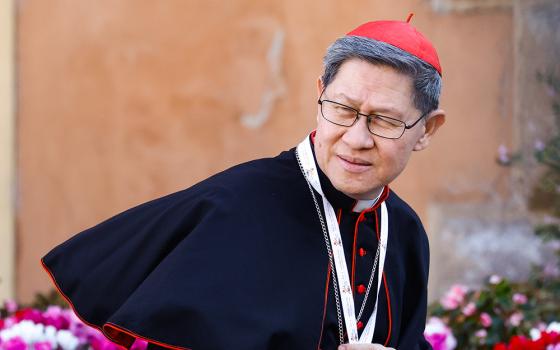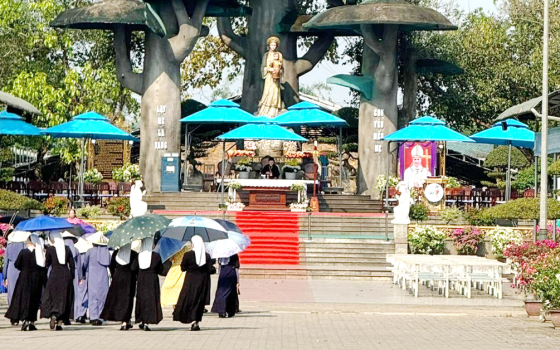Some years, there is a justifiable debate about what was the lead story regarding the Catholic Church in any given year. In 2013, there is no such debate: The unprecedented resignation of Pope Benedict XVI and subsequent election of Jorge Mario Bergoglio as Pope Francis was not only the biggest religious story this year, the other competitors are derivative of that election.
The Pope Francis story is, of course, many stories, some of them still unfolding. So, let us look at some of the more important memes that have developed in telling the story.
First, there is the entire discussion of continuity versus discontinuity. The conversation tends to focus on ephemera but, in fact, touches on something foundational: How is discussion within the Church framed? Everyone can sense that there is obvious change. But, everyone also notes, some in relief and others in consternation, that Pope Francis “has not changed any doctrines of the Church.” Well, doctrines of the Church do not change, they develop. And, every pontiff brings his own life experience to the task of leading the universal Church, so there is always some degree of change when a new one is elected.
I would pose the answer to the continuity/discontinuity debate this way. There is great continuity between Francis and his two immediate predecessors, but there is great discontinuity between Francis and his two immediate predecessors as those predecessors were interpreted to an American audience by the likes of George Weigel, Fr. Richard John Neuhaus and Michael Novak, and those bishops who followed their lead. They chose to ignore or minimize Pope John Paul II’s call for a conversion of Western lifestyles away from consumerism, his support for union rights, his deep suspicions of modern capitalism. They downplayed Pope Benedict’s seminal statements about the environment and his attempt to place the moral teachings of the Church where they belong, as derivative of our dogmatic beliefs about the Trinity. They skated past the ambiguities in Dignitatis Humanae about what the Church means when it uses the word “liberty” or downplayed the obvious conception of liberty as a negative right from coercion that informed the founding fathers.
What is clearly different about Pope Francis is not this teaching or that, but the accessibility with which he discusses these issues and, especially, a more trenchant denunciation of the world economic system, one rooted in his experience as a bishop from the Global South. Yes, Pope Benedict, last year listed “unregulated financial capitalism” among side organized crime and terrorism as threats to world peace. But, Pope Francis not only raises this same concern, he goes to a slum in Rio for a cup of tea with some of the residents and invites homeless men – and their dog! – to breakfast on his birthday.
Second, it is fun to hear secular commentators explain their admiration for the pope by saying they are relieved he is not focused on doctrine or dogma but on helping the poor. Hello?!??!! What we call the “social doctrine” of the Church is as much “doctrine” as the Church’s teaching on the neuralgic, pelvic issues. Both flow from our dogmatic belief that men and women are created in the image and likeness of God, and by our dogmatic belief that in the light of the Incarnation, we understand human dignity differently, at a deeper level, even a more urgent level. The challenge for the Church is to explain that all of Her teachings are rooted in the empty tomb of Jesus Christ, or they have nothing distinctly Catholic about them. It is true, say, that two plus two equals four in every religious scheme, but the significance of mathematics or science or any human knowledge is a thing for philosophy and theology to determine, and, for Catholics, the role of philosophy is not independent of theology, the two must walk hand-in-hand. Pope Francis is not eschewing dogma. As regards criticisms of his economic understanding as evidenced in Evangelii Gaudium, the pope is not trying to win a Nobel in Economics. His statements are not even just moral exhortations, but something deeper, something dogmatic, something about the nature of human kind understood in the light of the nature of the Godhead. Here, I should note, we see him in deep continuity with Gaudium et Spes #22, Pope John Paul II’s frequent citation of that paragraph and virtually everything Pope Benedict every wrote, before or after his election.
Third, style and image matter to this pope but not in the way they matter for more conventional media sensations. Pope Francis lives in such a way that his lifestyle is almost iconic. I understand little about Eastern Orthodox theology, but insofar as I understand it, they believe that icons are akin to what we call “sacramentals,” things that are not divine in themselves but contain or convey something of the divine within themselves, and not just in a metaphoric way as one does when saying a beautiful sunset makes us sense God’s prescence, but something more tangible, something worthy of veneration. In the case of Pope Francis’ lifestyle, it is not a thing to be venerated but imitated, but like an icon, it not only communicates something about the divine, it is not a mere representation, it is itself holy, Christ-like. This is not about PR. It is about JC.
I mentioned at the top that I think there were other important stories in the life of the Catholic Church in the United States that warrant attention and all three of them are derivative of the Pope Francis story. Let us turn to them briefly.
First, there is the emergence of Boston’s Cardinal Sean O’Malley, OFM Cap, as the “go-to” guy in the U.S. Church. Just as Cardinal Gibbons had enormous influence on account of his role as sole cardinal in the U.S. for more than twenty years and Cardinal Spellman had special influence in the reign of Pope Pius XII, Cardinal O’Malley has become a key point man in part because, like Gibbons, he is deeply respected by his fellow bishops in the U.S. and, like Spellman, because of his close relationship with the pope. Regular reads will know my bias: I have known Cardinal O’Malley for nigh to twenty years and consider him a friend, but he is much more than a friend. He is apostolic. You can imagine him in the Upper Room. He does not need any primer on the Church’s social doctrine and he has always understood that the Church’s pro-life commitments are not at odds with Her social justice teachings but a part of those teachings. Like the pope, he lives simply, in an iconic way, and always has. Again, admitting my bias, I can’t think of a healthier, holier, and smarter person to have the pope’s ear nor one who, unlike Spellman, will never use his influence to undermine the USCCB or his brother bishops.
Second, the USCCB, while not stepping away from its fight with the Obama administration over the
The final key development was the selection of Cardinal Donald Wuerl for the Congregation for Bishops and the removal of Cardinals Raymond Burke and Justin Rigali. This decision by Pope Francis will not only have immediate effects, it will have long-term effects on the future shape of the Catholic Church. Like O’Malley, Wuerl has been giddy about Pope Francis since his election in March. Cardinal Wuerl has not re-published emails complaining about the pope in his diocesan newspaper nor expressed “disappointment” with him for not talking more about abortion. Nor has Wuerl, like the cardinal he replaced, suggested that Evangelii Gaudium was not really an exercise in magisterial teaching, despite the fact that the text says otherwise.
If you had told me on New Year’s Day last year that any of the above would happen, I would have been deeply skeptical. But, happen it did. There is new life in the Old Girl yet. Holy Mother Church has fresh wind in Her sails. Up here in Connecticut, I have seen people I have not seen all year and all of them want to talk about the pope. It is an exciting time. Yes, the problems in Newark and St. Paul and on-going scandal in Kansas City are tragic and troubling, but they are not the dominant story this year as they doubtless would have been if Benedict XVI had not stepped down and if the cardinals had not chosen as they did. Pope Francis is not only Time’s “Person of the Year,” he is, more importantly, so obviously the pope the Church needs at this moment. And I have a feeling that next year will be just as exciting.






